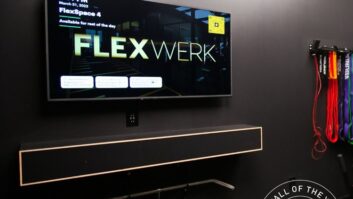In the world of consumer electronics and custom installation, format battles and the discussion of “who will win” is as old as Tesla and Edison fighting the “Battle of the Currents,” CBS and RCA sparring over color TV standards, Beta vs. VHS, and all the way up to today’s “Blu-ray vs. HD-DVD” contest. It is easy to come away from an event such as last month’s International Consumer Electronics Show and proclaim a winner to a format battle, but don’t jump to conclusions.
Yes, Tesla’s AC current won the day, as did RCA’s compatible color system. Just remember, CBS seemed to have it all wrapped up, but you don’t see many mechanically scanned color television systems these days. Yes, VHS won the battle of the video cassette formats, but, when pressed, most observers will admit that Beta was the better format.
Sometimes there isn’t winner and formats co-exist. FM and AM live side by side just as 33 RPM and 45 RPM vinyl records were sold side by side for years. Sometimes the former combatants live side by side, but not because there is room for two. Rather, the market often telegraphs a sense of ennui signaling that that no one really cares one way or the other. DVD+RW vs. DVD-RW: does it really matter anymore as long as you can purchase blanks in both formats with relative ease? (You can.) DVD-Audio vs. SACD: does anyone really care anymore? You get the picture.
If you look at last month’s CES from the vantage point of which formats and products will win in the marketplace you may just end up with an interesting view of the show, and that’s exactly what we’re going to do.
Blu-ray vs. HD DVD
While many were counting HD-DVD out after Warner’s announcement that it was going to release titles exclusively on Blu-ray, HD-DVD continued to put on a game-face at CES with this display in the Toshiba booth. Last year at CES, Warner lit a big fire under the high-definition disc wars by announcing its dual-format Total HD discs. A nice idea that, if adopted, could have made the format war moot, but as 2007 moved forward it proved not to be. When Paramount announced that it would be releasing its titles exclusively on HD-DVD the tide seemed to turn, but with almost perfect timing, Warner made news right before CES again this time by announcing that it would drop HD-DVD support in May and move exclusively to Blu-ray. To many that seemed to end the battle, and perhaps in the long run it may well be the defining moment in this format battle. I believe that it is still a bit too early to tell. As one might expect, the Blu-ray camp made a big deal of the announcement in their own booth.
Toshiba and the two studios still supporting HD-DVD (at least as I write this in mid-January) continue to put up a valiant front. Time will certainly tell if there will be a winner or loser, and if so whom. Or, consider that in the long run there may be no true winner here. Again, let’s recall DVD-Audio and SACD. While iTunes and other most other electronic download services with the exception of the likes of Music Giants don’t offer content with anywhere near the of the quality of either of the two optical high-resolution audio formats, that hasn’t stopped electronic content delivery from putting a big dent in standard CD sales and reducing the two previously warring high-resolution formats to all but anonymity. Will the same happen here, with HD video content delivered electronically via some form of IPTV? It may be a bit too early, but if there is a winner, how long will that championship reign?
The Battle for Largest Display
Another battle, if you will, at CES in recent years has been to claim the right to “the largest screen.” Last January the title was wrested away from Panasonic’s 103-inch-wide plasma set by Sharp’s 108-inch-wide LCD. That leap of just five more diagonal inches was simply blown away this year as Panasonic took things back with an incredible 150-inch-wide plasma display. Imagine, a flat-panel display that is more than 12 feet diagonal, more than six feet high and 11 feet wide. This is no mere 1080p set. Its resolution was quoted at 4096×2160, which is four times that of a standard HDTV display.Panasonic’s 150-inch-wide plasma display is an incredible piece of technology, but does its size limit the places where it can be used?
That’s all well and good, but when it becomes available at an as yet undisclosed price during 2009, will it be a winner for you? Perhaps, if you have a client willing to practically build their home theater, if not the entire house around it. Clearly a showcase display for public venues, you have to ask yourself–and your clients–if this is simply a case of looking elsewhere for a winner. After all, for what this display will have to cost, isn’t a more two-piece projection system in order?
RPTV vs. Flat Panels
Talking about “winners and losers” in the display world, many have begun to write off rear-screen projection televisions (RPTV) in favor of flat panels. After all, with Sony announcing in late December that they were bowing out of that category, there remain only a few major brand supporters of RPTV. At CES, however, it was clear that RPTV has not yet thrown in the towel.
Samsung used the show to demonstrate the benefits of LED illumination and the potential for 3D applications. More importantly, and with greater publicity, Mitsubishi did more than just show its latest 3D-capable RPTV. The display, shown at an off-site location, was the premiere of a “close to final” version of its laser-illuminated offering. If anything has the potential to bring RPTV back to “winner” status in both the custom installation and broader consumer markets, this is it.
Details as to final screen sizes, pricing and availability are still to be announced, but we can expect shipments by mid-year. Judging from the demo models, Mitsubishi will make good on the promise of bringing a narrow-depth footprint and incredible contrast and color reproduction to RPTV. It will be interesting to see if the marketplace agrees.
Plasma Battles LCD
Yet another contest where everyone is looking to see who the “winner” is has been the debate over the relative merits of plasma vs. LCD technology. That one lingers on, though for the most part all might agree that for the next year or two it will remain a back-and-forth where both technologies have their merits and weaknesses.
At CES we were able to see some of the ways in which the two competitors will stake their claims for supremacy. Pioneer’s “Project Kuro” plasma displays demonstrated a future technology billed as “extreme contrast” that all but eliminates idle-state luminance to deliver pictures with incredible “punch.” Unlike other PDP and LCD sets, when the set is turned on, but there is no image on the screen, you almost can’t tell it is there. This won’t be inexpensive when it appears in production products in about 18 months, but it has all the earmarks of a winner.
The Thinner the Better?
Back to the size of displays, another race was underway at CES, but here there may be a variety of “winners.” Virtually all the major flat-panel brands, in both plasma and LCD were touting “thin” products at CES, many significantly thinner by 30 percent or more than current sets. For the moment the benchmark is one and a half inches deep, as that is what Hitachi is promising for sets that they will deliver before mid-year. At or about the same mark will be 1.7-inch deep LCD sets from LG, and more from other brands.Thin was definitely “in” at CES, as shown here by Hitachi’s display of their 1.5-inch thick (or is it thin?) LCD sets. They look great, but remember to think about how you will mount them.
As time moves forward, many manufacturers will push the envelope even thinner, with Sharp, Samsung, and others promising LCD displays well under three quarters of an inch while Hitachi and Pioneer touting prototype plasmas, in the case of Pioneer’s Project Kuro, going well under half an inch thick. However, these “super thin” sets are easily 12-18 months, or perhaps even more, away.
No matter how you look at it, the thin sets look like a winner for the manufacturer with the slimmest profile display, for you in having a specialized, sheltered distribution product that will not likely appear in the big box stores (these things won’t be cheap!) and, lest we forget, for your clients. Here, everyone’s a winner, right?
Not to be “Debbie Downer”, but take a deep breath before you start specing these technological wonders into jobs. First, remember that these are the front-to-back measurements of the set, but what about the mount? Yes, equally slim mounts will appear as well, but they will add to the total “off-the-wall” footprint of the TV. These sets will also be light weight, but they won’t stick to the wall with Velcro! Provided that you’ve taken care of ventilation requirements, perhaps one unexpected benefit of the thin profile of these new-generation sets will be the ability to mount them in-wall, rather than on-wall. This clearly requires the expertise that only an experienced custom installer can provide, taking it well beyond the capabilities of the average do it yourselfer and your less skilled competitors.
Next, remember that you still have to account for the connectors and power cord, and depending on how the sets accommodate jacks and plugs, they have to be figured into the set. If it is of concern for a specific installation, note, also, that the super thin sets are all monitor-only models. Adding a tuner must clearly add some depth, for as JVC says in its CES press release, their forthcoming 42- and 46-inch slim sets are 1.5 inches thin, but that is “…across most of its width…with a maximum depth of 2.9 inches at the panel’s center. Clearly, you are going to read the spec sheets for these sets very carefully and plan your installations accordingly.




Another cautionary note on the slim sets is that they are mostly in the 37- to 46-inch-diagonal size range, pointing to a trade-off at least for now in slim depth in exchange for screen size.
While some manufacturers claim to be the winner in thin depth, another way to look at flat-panel displays is in their overall area, bezel included, rather than depth. The concept here is to shrink the bezel width so that the viewable screen area can increase for a given total area. Or, as Toshiba showed with their winning claim, “…a 40-inch-wide set in the space of others’ 37-inch, a 46-inch-wide set in the area of others’ 42-inch, and a 52-inch-wide set in the space of others’ 46-inch. Where you are doing a retro fit or have to shoe-horn the largest size possible into existing cabinetry, finding the winner in slim bezel design makes a great deal of sense.
On the other hand, while the use of slim-bezel designs make it possible to fit a set with a large screen size where it might not be possible with a thicker bezel, beware of the implications this has for speakers. If you are filling up a predefined space in cabinets or a wall unit with a large area, thin-bezel display, think about where you will put a center-channel speaker, not to mention any left/right channel speakers other than those built in to the display. These sets tend to sit low to the surface with what designers have called a “low chin” when describing RPTV cabinets. As you bask in the triumph of being able to provide a larger video screen, don’t forget to leave room for speakers if they have to live in the same space as the display.
The Race to Wireless HD
Trying to figure out how to make physical signal connections to the new thin displays might turn your thoughts to wireless, and coming out of this year’s CES you would not be alone in considering that alternative. The concept involves high-bandwidth wireless systems that let the control center for a display and any input selection be placed at one end of the room, while the display sits in or on the wall. That is certainly a winner, but here the problem is which wireless system to use. Virtually all of the major display brands showed an HD-capable wireless transmission solution, and almost each of them was unique. That is not a winning idea.LG was only one of the many video display brands showing demonstrations of “Full HD” wireless connectivity between a source and display.
Wireless is commonplace in many homes for data networking, but the bandwidth required for HD is significantly greater, and the stability of service required is considerably greater. A missed data packet in a download can be recovered or repeated. If the wireless system hiccups in the middle of a clutch play in a major sports event, it is your phone that will ring with an angry client on the other end, not the manufacturer’s. Long term this will be a winning idea, and it is possible that there may be a single winning methodology. But for now, it is almost “every one for themselves.” Caveat emptor.
OLED as a Display Option
Before leaving our survey of winners from the display scene at CES, it is appropriate to mention Sony’s announcement of commercial availability of an 11-inch OLED display. Your clients will likely be the first on their block with this new technology if you purvey one at $2,500, and the benefits will be bright, high-contrast images in a very slim form factor. Whether OLED is a winner in the long term, however, remains to be seen.
There were prototype demonstrations at CES from Sony and Samsung of larger OLED sets, but only time will tell if they can be made in high volume, in true home theater sizes (40 inches and above), and if the reports of a life span that is less than that for LCD and PDP hold true or if they can be overcome. If the answers are yes, then OLED steps right into the display battle grounds. For the moment, however, your options are limited to the one relatively small-sized model available. This one is still too early to call. Delivery of content directly to video displays will become a high-end feature this year that creates new opportunities to expand the your value in providing home networking services.
Coming out of CES, one technology that, at least for the time being, seems to be on the list of losers is CableCard. None of the new displays we saw at CES featured CableCard capability, though there may have been some out there. That’s something you might actually miss, as it means that your clients will no longer be able to watch scrambled/pay content without the use of a set top. Yes, you can still provide access to local HD cable signals and anything that is “Clear QAM” when the tuner is so equipped, but for now it seems that CableCard has run its course.
On the other hand, CableCard is still a critical component for custom installers when you place an HD TiVo or current-generation, HD-capable Media Center/Windows Ultimate-based product top in a job. Don’t let the current dearth of CableCard sets lead the nice folks at the local cable company to tell you they don’t have any. If you ask them for one on behalf of a client (or even for your own home theater) and they give you that funny look, gently remind them that “it’s the law.” While they may make things difficult and insist that their technicians come out to the job site for an installation, they must supply a CableCard to you on request.
Content Delivery Developments
One concept that could be judged a winner, based on the number of products incorporating it at CES, was the delivery on content directly to a video display. You might even call this a great win for you, as it extends the requirement to extend the home network in new ways in each home’s installation.
If there was any question of the interest on the part of the content world in CES and, but direct extension to the products and services you are involved with, one needed to look no further than a huge booth right in the middle of the Las Vegas Convention Center’s Central Hall. There, where many a consumer electronics company once had their display, was a major presence from NBC Universal. On the one hand you might question their presence, as they really had nothing to sell directly to the attendees. On the other hand, a booth with constant live broadcasts on CNBC and Brian Williams anchoring NBC Nightly News live from the convention floor drove home the relationship between content and consumer electronics, with electronic delivery in many forms at the top of the list.Anyone doubting the importance of consumer electronics to the world of content at CES had to look no further than the NBC Universal booth where NBC Nightly News broadcast live from the Convention Center floor.
It remains up to us to see what products will be used for streaming, storage, content management, and re-distribution throughout a residence, but the trend seems unstoppable.
In the short term, one new way of merging content with hardware is in the many video displays that incorporate direct Internet connection to enable push content for text data such as sports scores, local news/weather/traffic, and financial market data. Going forward, the applications will include richer content, as evidenced by LG’s aligning with Netflix to deliver movie content directly to a video display or Sony’s content deals with CBS, Yahoo!, AOL, and more to deliver both episodic programming and movies along with additional content deals. Whether any of the specific products and services shown at CES to deliver, manage, distribute and display IP delivered content will be winners also goes into the “remains to be seen” bucket. However, the concept itself seems pre-ordained to be a winner. As the year moves forward, and as a better picture develops on the trends from CES, we’ll get back to them on a regular basis in more detail.
More Winners, Losers, and Undecideds
With space running out for this report, we’ll switch here from the global-view winners, losers and undecided’s to a few single product winners that cropped up at CES. After all, no CES report is complete without one or two of them.
A good example of a winner in a category you might not have thought about for home networks is a data safe. Here, I mean that literally, and not just in the sense of a backup drive, but in a product’s ability to safeguard your, or a client’s data in the event of a fire. Not a category, or in this case a company you normally associate with consumer electronics or custom installation, let’s think safes, and a leading company in that field, Rochester, New York-based SentrySafe.
SentrySafe’s FIRE-SAFE/Waterproof hard drives are literally just that, 80GB or 160GB Maxtor drives configured for one-touch back-up in an enclosure that is verified for fire protection for 30 minutes at up to 1,500-degrees F and waterproof in a fully submersible environment for up to 24 hours when the fire fighters arrive to put the flames out. Need more protection or larger drive size? Their FIRE-SAFE QE5541 looks like a conventional floor safe and it protects its contents for two hours up to 1850-degrees F with water resistance up to eight inches for a full day. Designed to accommodate and protect data discs and file folders, this safe is unique due to an external USB 2.0 powered port that lets you put a 2.5-inch USB drive in a pocket in the safe’s inside door and connect it to the network for backup without having to open the safe or be limited by drive size (as long as the drive does not require external AC power). This is an idea that will have your clients naming you as a winner.
Seemingly simple, but a winning concept, is a cordless wall sconce from Energizer that uses LED illumination for low power consumption. This winner is perfect for out of the way locations where AC power isn’t available, or for emergency lighting in something a bit more attractive than a standard industrial fixture.
Finally, reflecting a major CES theme of “green,” energy conservation, and lower carbon footprints, Belkin showed its “Conserve” eight-outlet surge protector. At first glance it appears to resemble a zillion other power strips and surge protectors, but where it differs is in the fact that six of the eight outlets are controlled by a remote control that shuts them off when not in use.
While that may not seem like a big deal, think about all the chargers for cell phones, digital cameras, portable audio/video players, and the like that are plugged into power strips. Even when the devices are fully charged or even removed, power is consumed and there is normally no easy way to turn the power strip off when it sits on the floor or hidden behind a cabinet. With the Conserve’s remote–presumably something you can program into a home automation system, as well–the strip can be turned off without any effort when the devices are removed. Perhaps this saves only a little bit of energy, but over time it adds up.
As noted, there was much more to CES than winners and losers, perhaps with no better lesson here than to look beyond who won or lost to see if anyone really got an award or not, and if so why. After all, the most important award is the one a client gives you when you win a bid, and can provide the level of service that keeps them in your corner for the long term.
Michael Heiss ([email protected]) is an industry consultant in Los Angeles, California.










